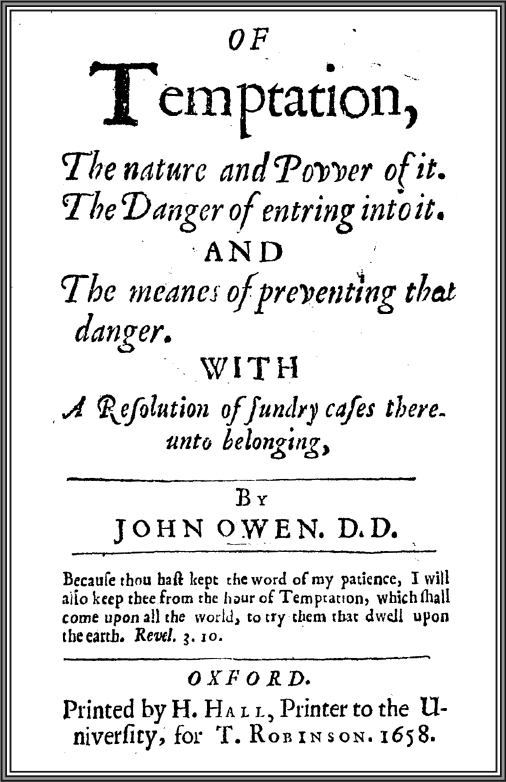OF TEMPTATION: THE NATURE AND POWER OF IT
JOHN OWEN begins this work by citing Christ’s instructions to his disciples: “Watch and pray, that you enter not into temptation” (Matt. 26:41). Three elements within this verse constitute the main themes of this work: (1) the evil cautioned against (temptation); (2) the means of its prevalency (by our entering into it); and (3) the way of preventing it (watch and pray).1
In Part 1 Owen looks at the nature of temptation itself (chapter 1). In general, temptation is a neutral term that signifies testing something. The special nature of temptation, on the other hand, denotes evil, whether passively (when we are afflicted) or actively (when we enter into temptation). Owen goes on to suggest the reasons and the means for God’s tempting, as well as the way in which Satan tempts. His working definition of temptation is “any thing, state, way, or condition that, upon any account whatsoever, has a force or efficacy to seduce, to draw the mind and heart of a man from its obedience, which God requires of him, into any sin, in any degree of it whatsoever.”
Part 2 (chapter 2) addresses the danger of entering temptation. He explains what “entering temptation” is and is not. It is neither being tempted nor being conquered by temptation, but rather falling into and being entangled by the snares of temptation. He explains what must happen in order for us to enter this state and how we might know why temptation is “at its hour.”
All of this is preparation for Owen to advance his thesis in Part 3 (chapter 3), namely, that “it is the great duty of all believers to use all diligence in the ways of Christ’s appointment, that they fall not into temptation.” He offers a number of general considerations to demonstrate this thesis, then entertains a series of objections and questions. Part 4 (chapters 4–9) then looks at particular cases arising from this proposed truth. He explains how one knows whether or not he has entered into temptation (chapter 4), how to preserve one’s soul from entering into temptation (chapter 5), how to be aware of the seasons wherein people usually enter into temptation (chapter 6), how to watch the heart itself (chapter 7), and how to keep Christ’s word about patience. He then closes with some further exhortations related to the duty of believers to watch.
1 Our section divisions don’t correspond to this exactly because Owen’s actual text is not quite this neat. William Goold, editor of the nineteenth-century editions of Owen’s Works, wrote: “Slight defects in the arrangement, the renewed discussion of a point after it has been quitted, and the disproportionate space accorded to some parts of the subject, are explained, perhaps, by the circumstances that the treatise was originally a series of discourses” (Works, 6:88). A detailed outline of Of Temptation: The Nature and Power of It is found at the end of this volume.
